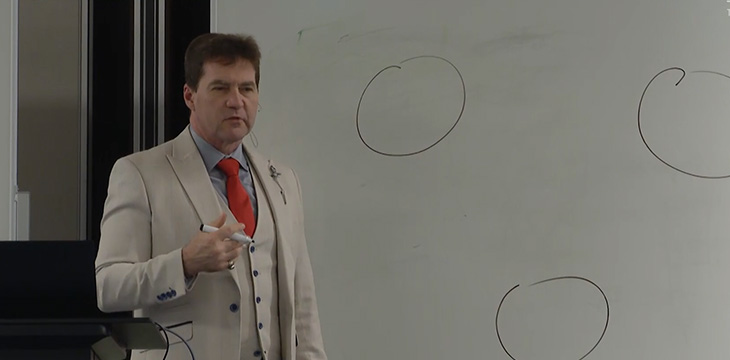|
Getting your Trinity Audio player ready...
|
In the third session of the second day of The Bitcoin Masterclasses in Slovenia, Dr. Wright delved deeper into the structure of distributed systems and addressed how we might link, index, and search for information on them.
How should distributed systems look?
Dr. Wright begins with a demonstration of how BTC works today. He shows how nodes do not transact in a truly peer-to-peer way but rather send information to ISPs that relay it on.
“It’s not a mesh network with multiple connections, but we can still do that,” he says.
What if one of our links goes down? We lose our connection. That’s why we might want to have multiple links. Dr. Wright says the more links we have, the more it will cost, but the better the overall resilience will be.
“As Bitcoin itself is distributed, your individual node can also be distributed,” he says.
Looking back to an earlier lecture, Dr. Wright reminded the attendees that we discussed applications in different locations, such as data centers and cities. This makes them far more resilient.
As well as the physical location of nodes and the infrastructure they run on, we must also think about how they connect to and communicate with each other, Dr. Wright says, adding to his diagram. In a three-node setup, we can use multicast, ensuring the information the main node broadcasts go to the other two.
As Dr. Wright said in his first Masterclass series in London, with User Datagram Protocol (UDP), if the information doesn’t reach the other nodes, then it just doesn’t reach it, and any detection of information being missed will have to be at the application level. However, with Reliable Data Protocol (RDP), the packets will be retransmitted (including by anycast) until the other nodes receive them. We have to think of all this when designing the systems that will act as part of a corporate network or as part of applications.
“If we start thinking about a decentralized distributed system, it’s not about avoiding legal responsibility [like the crypto bros]; it’s about making something that will keep working, even allowing disaster zones to continue operating,” Dr. Wright tells us. The most important thing to think about is how to structure them.
Linking, finding, and searching for information
Looking at the bigger picture, Dr. Wright says all of this could be the birth of a new type of data center. Perhaps Amazon (NASDAQ: AMZN) won’t run everything in the future.
When building applications and sorting information, we need to be able to find it, link it, etc. “Why do you think Google searches for information? What is it that Google is providing?” Dr. Wright asks. It’s an index.
When we have these multicast groups we’ve been speaking about, we will need to find ways of linking information between the groups so people know it’s there. The groups will also have to have ways of responding and allowing people to join them. While we may have some traditional approaches, databases of databases are the likely outcome, Dr. Wright tells us. We’ll have to leave behind the notion of there being “one big Google out there.”
When we’re talking about accessing all of this, that’s where payments come in. Google (NASDAQ: GOOGL) doesn’t do what it does out of altruism; it’s all about profit. Likewise, any alternative will be driven by the same profit incentive.
Despite being the biggest search engine, Google isn’t very good, and as a result, we have a “terrible internet,” according to Dr. Wright. He outlines how we could have searches that bring up only what we’re looking for, such as the name of a band and its music, since the band will have paid to host their music on a node and will receive micropayments when it’s played.
Watch: Bitcoin Masterclass 2 with Craig Wright on Multicast & IP2IP

 12-13-2025
12-13-2025 





